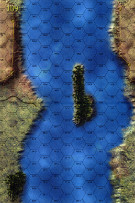|
The Long Run Blue Danube #4 |
||
|---|---|---|
| (Attacker) Austria-Hungary | vs | Serbia (Attacker) |
| Formations Involved |
|---|

|
| Overall Rating, 1 vote |
|---|
|
3
|
| Scenario Rank: --- of 969 |
| Parent Game | Blue Danube |
|---|---|
| Historicity | Alt-History |
| Date | 1940-09-06 |
| Start Time | 04:00 |
| Turn Count | 15 |
| Visibility | Day |
| Counters | 7 |
| Net Morale | 0 |
| Net Initiative | 2 |
| Maps | 1: 109 |
| Layout Dimensions | 43 x 28 cm 17 x 11 in |
| Play Bounty | 151 |
| AAR Bounty | 167 |
| Total Plays | 1 |
| Total AARs | 1 |
| Duplicates | RiFl004 |
| Battle Types |
|---|
| Meeting Engagement |
| River Control |
| Conditions |
|---|
| Minefields |
| Reinforcements |
| Scenario Requirements & Playability | |
|---|---|
| Blue Danube | Base Game |
| River Battleships | Maps |
| Introduction |
|---|
|
Below Belgrade, the Danube has a stretch of relatively straight and unobstructed flow. Now that the meddlers in Pola had been silenced (at least for the time being) by the terror attack on Belgrade, Trapp could focus on control of the stretch of the Danube leading up to the Iron Gates. It was imperative to keep the Serbian and Romanian flotillas from combining as the combination of the two might be enough to overwhelm the Austro-Hungarian flotilla. Austria-Hungary was well-endowed with transportation in southern Hungary. The years between the wars had seen incredible development in the area. Serbia, on the other hand, experienced significant development only along the Danube. Railways and paved roads remained few and far between in the kingdom and civilian watermen continued to carry most of the trade of Serbia. Even with a war, movement of food and necessary goods continued to be accomplished by riverboat. Ritter von Trapp resignedly authorized the laying of mines in the Danube below Belgrade for the express purpose of deterring any link-up between the two opposing flotillas. He did so in the clear knowledge that this would also cause significant hardship to the population of the developed portion of Serbia. This was early in the war when concerns over civilian disruption were not considered a quaint affectation. |
| Conclusion |
|---|
|
A barrier such as an effective minefield would keep the Romanians from joining the Serbians and permit Ritter von Trapp to concentrate on destroying one or the other flotilla. While the Romania river ports were far off, the need to keep the Serbians and Romanians from consolidating their forces was critical to the Imperial and Royal Navy's plans for the campaign. The braintrust in Pola had decided that Belgrade must fall. A side note is required at this time. The mining of the Danube by the Imperial and Royal Navy has been added to the claims of wartime terrorism by revisionist historians. In a campaign designed to destroy the memory of Ritter von Trapp and the men of the Danube flotilla, the mining and the earlier bombardment of Belgrade have been termed terrorism of the most severe sort. It should be noted that the bombardment of Belgrade was, indeed, a terror attack but had been undertaken with great reservation by Trapp and subsequent documents have proven his reticence to perform the task. The mining was done with the clear intention of a military result, thoroughly unlike the float-mining of the Rhine proposed by some backbencher in the British government. |
| Additional Notes |
|---|
|
Counters and maps from River Fleets may be used to play Blue Danube scenarios. |

 BlDb003
BlDb003 






